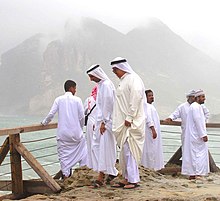User:Georgethewriter/sandbox

Dress in Saudi Arabia comes in traditional clothes to Western styles of dress, and generally wear modern adaptations of age-old designs. The loose, flowing traditional garments are practical for the Kingdom’s hot, windswept climate, and in keeping with the Islamic ideal of modesty.
Men[edit]
Thoub[edit]
Saudi men wear a full-length, loose garment with long sleeved called thawb. The normal color is white. It is made from cotton or a a polyester mix. However, this color is commonly changed into darker colors such as brown, navy blue, black during the winter. Winter's thawb are made from wool. The collar of the thawb comes in different styles. Some come in a rounded shape and others come in a triangular shape. Some of the thawb sleeves have a loose cuffs while others have tight ones. The tight cuffs are open and closed by placing a Kabak ( cuff buttons). Kabak comes in a variety of shapes and can be made of many different materials. Some are made by silver and decorated with diamonds or precious stones. Usually the style of the sleeve's cuff matches with the style of the collar.
Sirwal[edit]
Underneath the thawb, men wear a long or short capacious white pant with sash to draw in waistline known as sirwal. Short sirwals are mainly worn by most of the Saudi Men. Men of the Western Region usually wear long sirwal
Taqiyah[edit]

It is a white cotton hat which is worn directly over the hair. Wearing the taqiyah keeps the Ghutrah or Shumagh form slipping off the head. There are different styles of Kufeya, some are perforated and some are knitted. In some countries like Egypt and Sudan, men wear Taqiyah without anything on the top. This kind of Kufeya comes in different colors.
Bisht[edit]
Mishlah is a traditional cloak worn by men on the top of the thawb. It is usually made from cotton or camel/sheep wool. In special occasions like wedding, the groom wears bisht over the thawb. Mishlah comes in many colors like black, brown, gray, and cream color. Bishts are trimmed with beautiful golden embroidery. It comes with a standard or a free size that can be adjusted. When wearing the Mishlah, the right side of the bisht is tucked under the left arm.
Shumag[edit]
Shumagh is the same as Ghutra. It is folded into a triangular shape and placed on the top of the head. The difference between shumagh and ghutra is that shumagh is embroidered with white and red threads.
Igal[edit]
On the top of Ghutra or Shumag, doubled black rope-like cord called igal is worn in order to hold ghutra in place. Igal is generally made of tightly woven black goat-hair and sheep's wool. Igal should not wrap around the forehead as kufeya do.
Gutra[edit]
Ghutra is a square shaped cotton fabric. It is folded diagonally to form a triangular shape. When it is worn, Gutrah is also folded from the front. Men wear gutrah on the top of Kufeya. Some men wear ghutra directly over the head without any Taqiya. The typical color of Gutrah is white.
Women[edit]

Women customarily wear a black outer cloak (abaya) over their dress, which may well be modern in style. On their heads, Saudi women traditionally wear a shayla – a black, gauzy scarf that is wrapped around the head and secured with circlets, hats or jewelry. Traditional dress is often richly decorated with coins, sequins or brightly colored fabric appliqués.
Some Saudi women wear veils made of sheer material. The practice of wearing a veil is an ancient one that dates back at least two millennia, before the advent of Islam. In a harsh desert environment, a thin veil provides protection from constant exposure to the sun, which can damage the skin and eyes. Today, a veil is also a sign of modesty and virtue.
All women have to wear Abaya on the top of there clothes when they go outside. Abaya looks like a black long dress with long sleaves. Saudi women have to cover their hair because of relegious reasons. The traditional Abaya covers the body fro the top of the head until the ankles. The traditional color of Abaya is known to be black. However, nowdays, Abaya became more fasionable and colorful.Some Abayas are embroidered with silver threads, cristals, lace and many other materials. Some Abaya are made form the jeans material, and some of them are totally made from the lace material and lined with a silk material.
Many women cover their faces in front of foreign men and this mainly due to traditions and customs. Women cover their faces with (Burga or Niqab) which is a veil or mask that covers the face except the eyes.
Almost in each region in the Kingdom there is a special custom. In the old days, Women used to wear these traditional dresses, but now, not all women wear this kind of costumes everyday. Today's girls usually wear the western clothes and wear the traditional dresses in some traditional occasions like Ghomra( the night before the wedding night), or in Ramadan occasions when they visit each other and have Iftar (breaking the fast) together.

